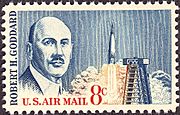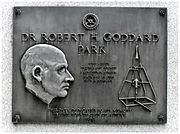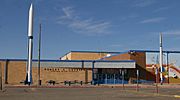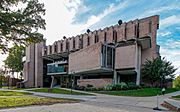Robert H. Goddard facts for kids
Quick facts for kids
Robert H. Goddard
|
|
|---|---|
 |
|
| Born | October 5, 1882 Worcester, Massachusetts, U.S.
|
| Died | August 10, 1945 (aged 62) Baltimore, Maryland, U.S
|
| Nationality | American |
| Education |
|
| Occupation | Professor, aerospace engineer, physicist, inventor |
| Known for | First liquid-fueled rocket |
| Spouse(s) |
Esther Christine Kisk
(m. 1924–1945) |
| Awards |
|
| Signature | |
Robert Hutchings Goddard (October 5, 1882 – August 10, 1945) was a brilliant rocket scientist. He helped make space travel possible for everyone.
Contents
- Robert Goddard's Early Life
- The First Liquid-Fueled Rocket
- Improving Rocket Technology
- Moving to New Mexico
- World War II and Rockets
- Death and Recognition
- Robert Goddard's Personal Life
- Key Achievements
- Why Robert H. Goddard Matters
- Interesting Facts About Robert H. Goddard
- Legacy and Influence
- Images for kids
- See also
Robert Goddard's Early Life
Robert Hutchings Goddard was born on October 5, 1882, in Worcester, Massachusetts. Even as a young boy, Robert loved the idea of space travel. He dreamed of building machines that could fly high and reach the stars.
When Robert was 16, he climbed a cherry tree in his backyard. As he looked at the sky, he imagined traveling to Mars. This moment sparked his passion for rockets. From that day on, he worked to make his dream real.
Robert was a smart and curious student. He studied hard and loved science and math. After high school, he went to Worcester Polytechnic Institute. Later, he studied at Clark University, where he earned his Ph.D. in physics.
While studying, Robert began working with rockets. He knew that rockets needed to be powerful to escape Earth's gravity. He started testing different fuels and rocket designs.
Building rockets was not easy. Robert faced many problems. He didn't have much money. Also, some people didn't believe rockets could ever reach space. But Robert was determined to prove them wrong.
The First Liquid-Fueled Rocket
One of Robert's biggest achievements was building the first liquid-fueled rocket. Before him, most rockets used solid fuel, like gunpowder. But liquid fuel, like gasoline or liquid oxygen, is much more powerful.
On March 16, 1926, Robert launched his liquid-fueled rocket in Auburn, Massachusetts. It was a small rocket, about 10 feet tall. It flew for only a few seconds, reaching a height of 41 feet. But it was a huge step forward! It proved that liquid-fueled rockets could work. This opened the door for future space travel.
Improving Rocket Technology
After his first successful launch, Robert kept making his rockets better. He created new designs. He also tried different fuels and invented new technologies.
One of his important inventions was the turbopump. This device pumps fuel into the rocket engine. Turbopumps are still used in rockets today. He also found a way to steer rockets using vanes in the exhaust.
Robert's work was amazing, but it was often hard. He usually worked alone with limited money. He faced criticism from people who didn't understand his ideas.
Moving to New Mexico
In 1930, Robert moved to Roswell, New Mexico. The wide-open spaces and dry weather there were perfect for testing rockets. With help from the Guggenheim Foundation, Robert built a research center and continued his work.
In Roswell, Robert and his team launched many rockets. They pushed the limits of what was possible. They developed bigger and more powerful rockets. These rockets reached higher altitudes and flew greater distances.
World War II and Rockets
During World War II, the military became interested in Robert's work. They saw that rockets could be used for military purposes. Robert and his team worked on developing rocket-assisted takeoff (RATO) units for airplanes. They also worked on other military technologies.
Even though his work helped the war, Robert always dreamed of using rockets for peaceful things. He wanted them to explore space.
Death and Recognition
Robert H. Goddard died on August 10, 1945. He was 62 years old. He didn't live to see humans travel to space. But his work created the foundation for the space age.
After he died, Robert's contributions to rockets were finally recognized. He was given many patents for his inventions. He became known as the "father of modern rocketry."
In 1959, NASA opened the Goddard Space Flight Center in Greenbelt, Maryland. It was named in his honor. The Goddard Space Flight Center is one of NASA's main research centers. It plays a very important role in space exploration.
Robert Goddard's Personal Life
On June 21, 1924, Goddard married Esther Christine Kisk. She was a secretary at Clark University. Esther loved rocketry and helped Robert with his experiments and paperwork. She also took photos of his work.
They enjoyed going to movies in Roswell. They also joined community groups like the Rotary and the Woman's Club. Robert liked to paint the New Mexican scenery. Sometimes he painted with the artist Peter Hurd. He also played the piano. Esther played bridge while he read. Esther said Robert was active in the community. He often spoke to church and service groups. The couple did not have children. After Robert's death, Esther organized his papers. She also helped secure 131 more patents for his work.
Key Achievements
- First Liquid-Fueled Rocket: Launched on March 16, 1926. This was a key moment in rocket history.
- Turbopumps: These pumps are vital for moving fuel into rocket engines efficiently.
- Steering Mechanisms: Goddard developed vanes in the exhaust to control rocket direction.
- Multi-Stage Rockets: He thought about and experimented with rockets that could drop parts to reach higher altitudes.
Why Robert H. Goddard Matters
Robert H. Goddard was a visionary who dared to dream big. He faced many challenges. But he never gave up on his dream of space travel. His inventions and ideas paved the way for the rockets. These rockets would later carry humans to the Moon and beyond.
Robert's story teaches us that anything is possible. You need passion, determination, and a willingness to work hard. He inspires scientists, engineers, and dreamers everywhere.
Interesting Facts About Robert H. Goddard
- Young Robert Goddard was a thin and sickly boy. He had stomach problems, colds, and other illnesses. He fell two years behind his classmates in school.
- He loved to read. He often visited the local library to borrow science books.
- As a child, Goddard loved being outdoors. He enjoyed hiking with his father. He also became an excellent shot with a rifle.
- Goddard's father encouraged Robert's interest in science. He gave him a telescope, a microscope, and a subscription to Scientific American.
- Goddard became interested in space when he read H. G. Wells' science fiction book The War of the Worlds. He was 16 years old.
- NASA's Goddard Space Flight Center was named in his honor in 1959.
- Two of Goddard's 214 patented inventions were very important. These were a multi-stage rocket (1914) and a liquid-fuel rocket (1914). They were big steps toward spaceflight.
- He was also added to the International Aerospace Hall of Fame and National Aviation Hall of Fame in 1966. He joined the International Space Hall of Fame in 1976.
- A crater on the Moon is named Goddard in his honor.
Legacy and Influence
- Goddard was given 214 patents for his work. 131 of these were given after he died.
- Goddard inspired many people who worked on the U.S. space program. These included astronauts Buzz Aldrin and Jim Lovell.
- Buzz Aldrin took a tiny biography of Goddard with him on his historic trip to the Moon aboard Apollo 11.
- Goddard received the Langley Gold Medal in 1960 and the Congressional Gold Medal in 1959.
- The Dr. Robert H. Goddard Collection is at Clark University's Robert H. Goddard Library.
- Robert H. Goddard High School in Roswell, New Mexico, was opened in 1965. Esther Goddard dedicated it. The school's mascot is "Rockets."
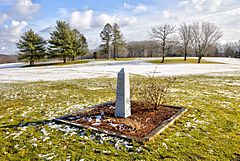
- The Goddard Rocket Launching Site in Auburn, Massachusetts, is a National Historic Landmark. It is now a golf course.
- A new experimental rocket from Blue Origin is named "New Goddard" after him.
- A beer called "Rocket" is made by Wormtown Brewery in Worcester, Massachusetts, in Robert Goddard's honor.
Images for kids
-
Charles Lindbergh took this picture of Robert H. Goddard's rocket, looking down the launching tower on September 23, 1935, in Roswell, New Mexico.
-
Bronze plaque in Auburn, Massachusetts marking the town in which Goddard launched the first liquid-fueled rocket on March 16, 1926.
-
Insignia of the 50th Anniversary of the Goddard Space Flight Center, a NASA facility in Maryland
-
Robert H. Goddard High School in Roswell, New Mexico.
See also
 In Spanish: Robert Goddard para niños
In Spanish: Robert Goddard para niños

















